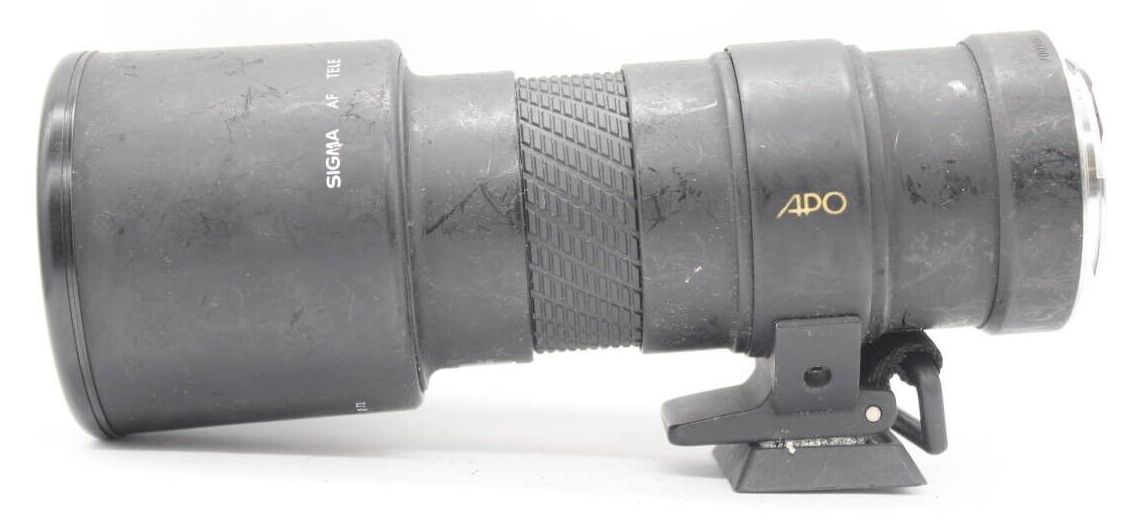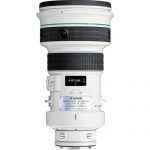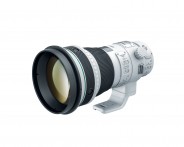Sigma 400mm F/5.6 Tele APO ZEN
Super telephoto prime lens • Film era • Discontinued
Abbreviations
| APO | Apochromatic optical design. |
Model history (3)
| ■Sigma 400mm F/5.6 Tele APO ZEN | A | 11 - 8 | 4.00m | ⌀72 | 1988 ● | |
| ■Sigma 400mm F/5.6 APO Tele Macro ZEN | A | 10 - 7 | 1.60m | ⌀77 | 1994 ● | |
| ■Sigma 400mm F/5.6 APO Tele Macro HSM ZEN | A | 10 - 7 | 1.60m | ⌀77 | 1996 ● | |
Specification
| Optical design: | |
| 35mm full frame | |
| 400mm | |
| F/5.6 | |
| 11 elements in 8 groups | |
| 2 SLD | |
| Internal focusing (IF) | |
| Floating element system | |
| Canon EF [44mm] | |
| Minolta/Sony A [44.5mm] | |
| Nikon F [46.5mm] | |
| Sigma SA [44mm] | |
| 6.2° (35mm full frame) | |
| On Canon EOS APS-C [1.59x] cameras: | |
35mm equivalent focal length: | 636mm (in terms of field of view) |
35mm equivalent speed: | F/8.9 (in terms of depth of field) |
Diagonal angle of view: | 3.9° |
| On Sony DSLR-A/SLT-A APS-C [1.53x] cameras: | |
35mm equivalent focal length: | 612mm (in terms of field of view) |
35mm equivalent speed: | F/8.6 (in terms of depth of field) |
Diagonal angle of view: | 4° |
| On Nikon D APS-C [1.53x] cameras: | |
35mm equivalent focal length: | 612mm (in terms of field of view) |
35mm equivalent speed: | F/8.6 (in terms of depth of field) |
Diagonal angle of view: | 4° |
| On Sigma SD APS-C [1.74x] cameras: | |
35mm equivalent focal length: | 696mm (in terms of field of view) |
35mm equivalent speed: | F/9.7 (in terms of depth of field) |
Diagonal angle of view: | 3.6° |
| Diaphragm mechanism: | |
Diaphragm type: | Automatic |
Aperture control: | None; the aperture is controlled from the camera (Canon EF, Minolta/Sony A, Sigma SA) |
| Aperture ring (Manual settings + Auto Exposure setting) (Nikon F) | |
| <No data> | |
| Focusing: | |
| 4m | |
| 1:9.5 | |
Focusing modes: | Autofocus (AF), Manual focus (M) |
Autofocus motor: | Micromotor (Canon EF, Sigma SA) |
| In-camera motor (Nikon F, Minolta/Sony A) | |
Manual focus control: | Focusing ring |
Focus mode selector: | AF - M (Canon EF, Sigma SA) |
| None; focusing mode is set from the camera (Nikon F, Minolta/Sony A) | |
Manual focus override in autofocus mode: | - |
| Optical Stabilizer (OS): | |
| - | |
| Physical characteristics: | |
| 1100g (Nikon F) | |
| ⌀85×212.5mm (Nikon F) | |
| Accessories: | |
| Screw-type 72mm | |
| Built-in telescopic round | |
| Sigma APO Tele Converter 1.4X EX → 560mm F/7.8 | |
| Sigma APO Tele Converter 1.4X EX DG → 560mm F/7.8 | |
| Sigma APO Tele Converter 2X EX → 800mm F/11.2 | |
| Sigma APO Tele Converter 2X EX DG → 800mm F/11.2 |
Source of data
- Manufacturer's technical data.
Manufacturer description #1
To minimize the colour aberration, which is the inherent problem of ultra telephoto lens, this lens is using 2 ultra low dispersion glasses in the front lens group. To have high speed AF mode and avoid heavy load to the AF motor, it incorporates inner focusing system. In addition, with a floating lens element system, it will produce high contrast and sharp image in entire focusing range from infinity to closest distance of 4 meters. It is a lightweight, compact, ease to use, high performance ultra APO telephoto lens.
Manufacturer description #2
Sigma's APO 400mm F5.6 is an ultra-telephoto lens which seeks the ultimate in compactness. In addition to a compact design with an overall length of just 8.36 inches (212.5mm) and a filter size of 72mm, the use of SLD glass provides sharpness and vivid colors throughout the entire image, even with the aperture wide open. The inner focusing system maintains a constant lens length and ease of manipulation so that manual focusing can be done even with a single finger. The APO 400mm, which performs well even with handheld shooting, has a minimum shooting distance of 13.1 feet (400cm) and a maximum magnification ratio of 1:9.5. It includes a built-in hood and front-end protective glass, making it a powerful companion in the field.
From the editor
Introduced at Photokina 1988.
Notes
- The autofocus will not be available with Nikon D40, D40X, D60, D3000-D3500, D5000-D5600 digital SLR cameras.
- Sigma had to reverse engineer the communication protocol of the Canon EF mount to produce a version of this lens for Canon EOS 35mm film SLR cameras. As a consequence, this lens may not work properly with Canon EOS cameras (both film and digital) due to compatibility issues.
Frequently asked questions
What does the Sigma lens designation "ZEN" mean?
It means that the lens has a ZEN finish. ZEN is an acronym for Zeitgeist ("the spirit of the times"), Enhancement, and Nonglare. This nonreflective urethane resin finish was introduced around 1989 and replaced the old-style, painted satin-black finish. Sigma claimed it to be hard, strong, antichemical, nonslip, antiglare, and scratch-resistant, however, it actually had a tendency to peel off and become sticky as it aged.
Lenses with similar focal length
| ■Canon EF mount (6) | |||||||||
| Canon EF 400mm F/4 DO IS USM | Pro | 2001 ● | compare | 9 | 2 | ||||
| Canon EF 400mm F/5.6L USM • ⌀77 | Pro | 1993 ● | compare | 4 | 1 | ||||
| Canon EF 400mm F/4 DO IS II USM | Pro | 2014 ● | compare | 10 | 2 | ||||
| Sigma 400mm F/5.6 APO Tele Macro HSM ZEN • ⌀77 | Pro | 1996 ● | compare | 4 | 2 | ||||
| Sigma 400mm F/5.6 Tele • ⌀72 | Pro | 1986 ● | compare | 0 | 0 | ||||
| Tokina AT-X AF SD 400mm F/5.6 Close Focus • ⌀72 | Pro | 1991 ● | compare | 1 | 0 | ||||
| ■Minolta/Sony A mount (4) | |||||||||
| Minolta AF 400mm F/4.5 HS-APO G • ⌀95 | Pro | 1995 ● | compare | 4 | 3 | ||||
| Sigma 400mm F/5.6 APO Tele Macro ZEN • ⌀77 | Pro | 1994 ● | compare | 2 | 2 | ||||
| Sigma 400mm F/5.6 Tele • ⌀72 | Pro | 1986 ● | compare | 0 | 0 | ||||
| Tokina AT-X AF SD 400mm F/5.6 Close Focus • ⌀72 | Pro | 1991 ● | compare | 1 | 0 | ||||
| ■Nikon F mount (3) | |||||||||
| Sigma 400mm F/5.6 APO Tele Macro ZEN • ⌀77 | Pro | 1994 ● | compare | 2 | 2 | ||||
| Sigma 400mm F/5.6 Tele • ⌀72 | Pro | 1986 ● | compare | 0 | 0 | ||||
| Tokina AT-X AF SD 400mm F/5.6 Close Focus • ⌀72 | Pro | 1991 ● | compare | 1 | 0 | ||||
| ■Sigma SA mount (1) | |||||||||
| Sigma 400mm F/5.6 APO Tele Macro HSM ZEN • ⌀77 | Pro | 1996 ● | compare | 4 | 2 | ||||









